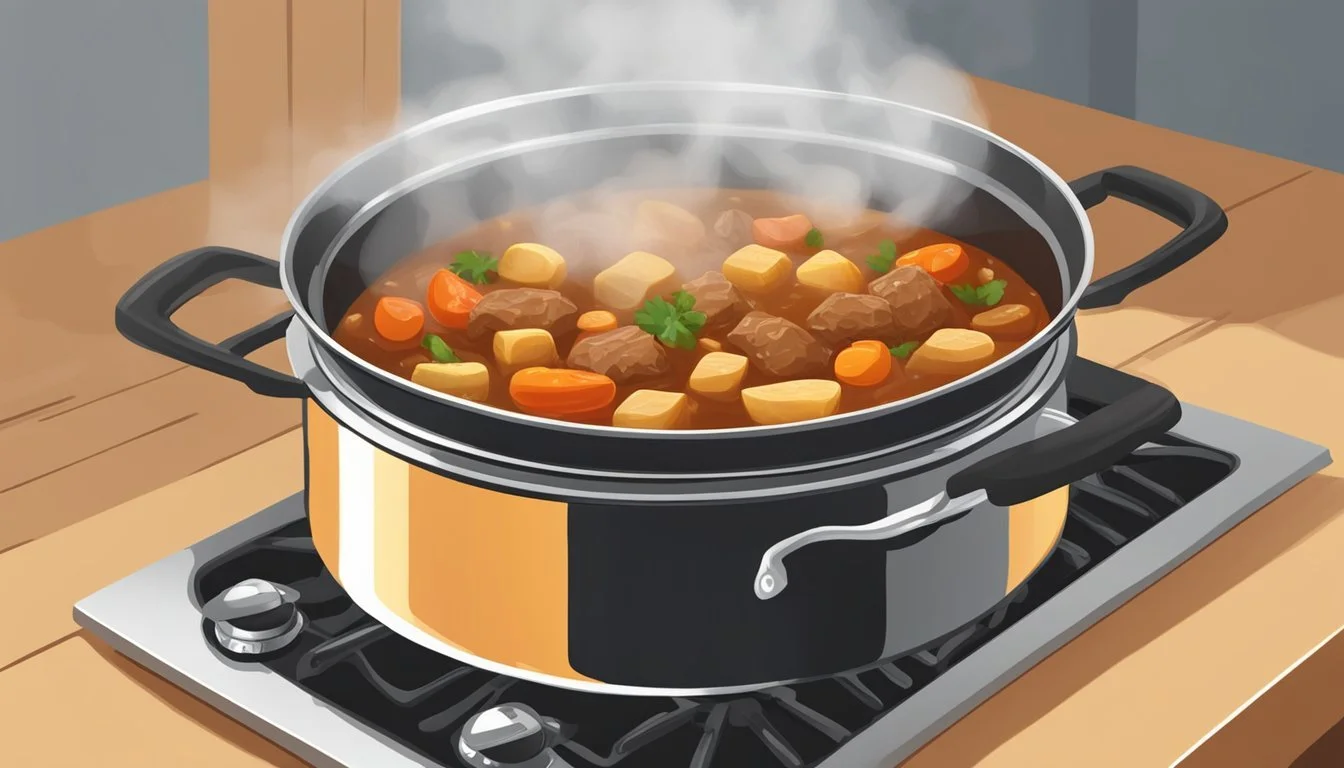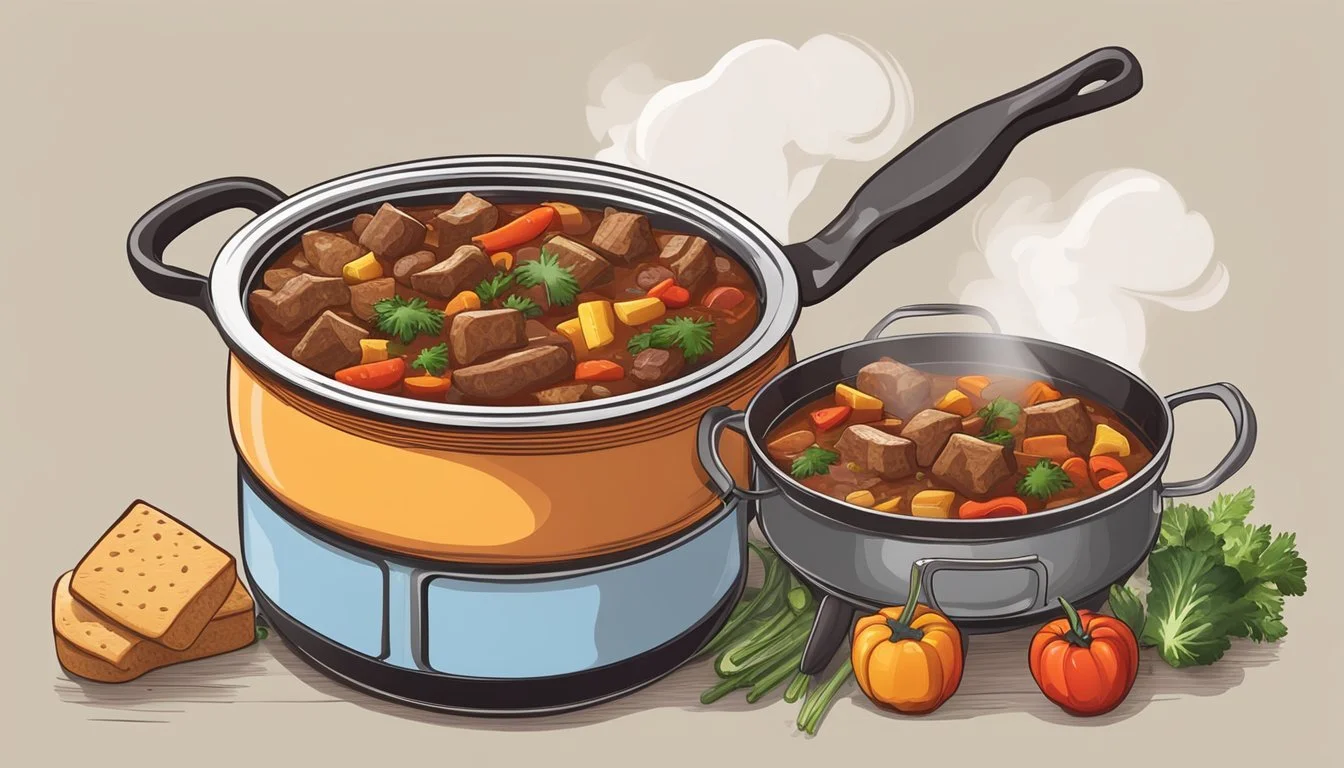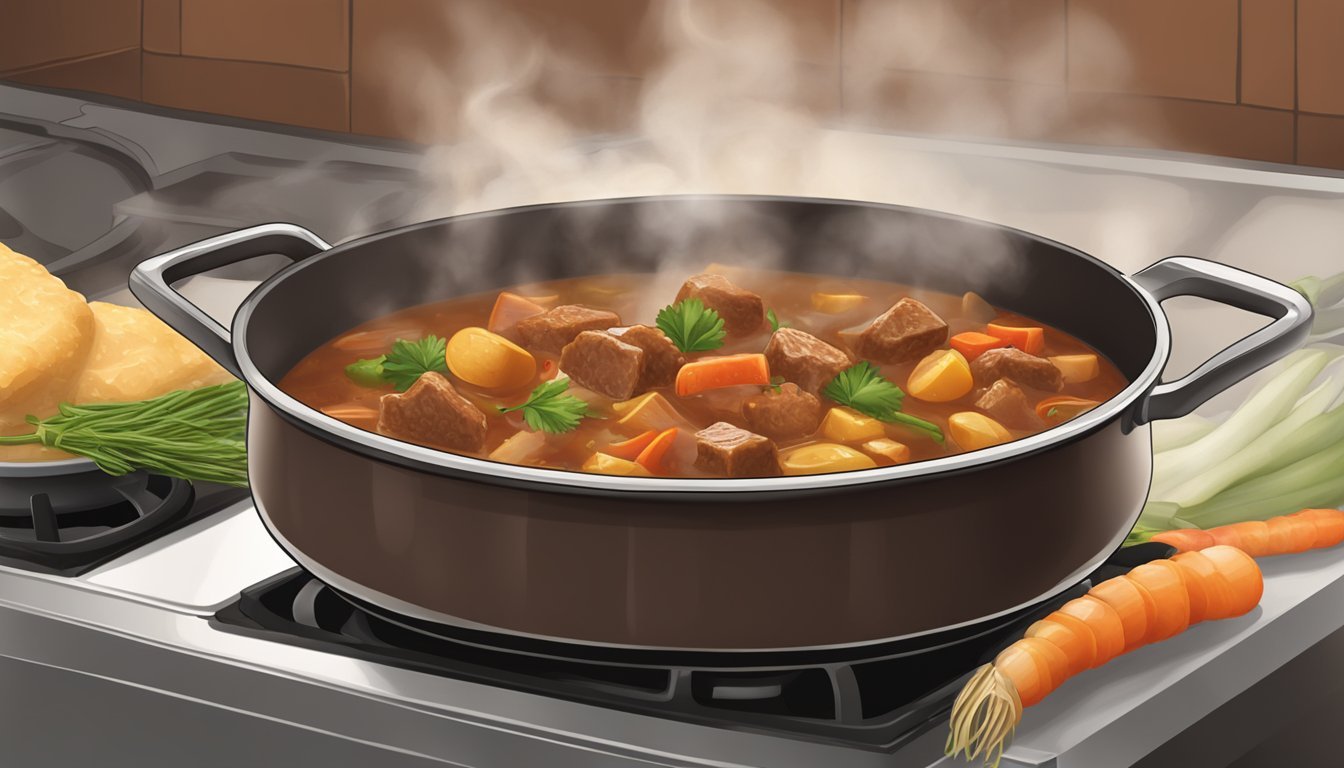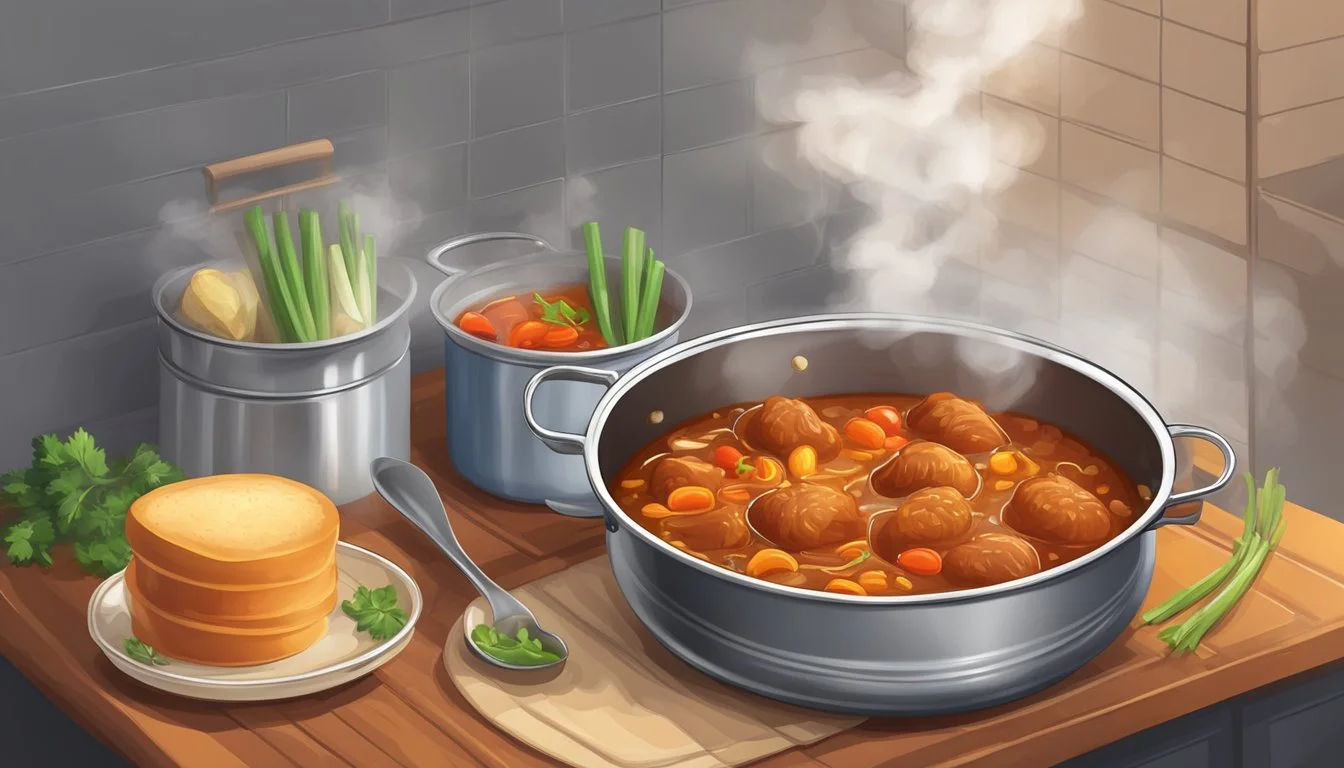Best Way to Reheat Hungarian Goulash
Tips for Preserving Its Flavor
Hungarian Goulash is a celebrated comfort dish known for its rich flavors and hearty ingredients. As with many stews (What wine goes well with stews?), it often tastes even better the next day, once the spices have had time to meld together. However, the challenge with leftovers is reheating without compromising the dish’s robust taste or tender texture. The key to reviving the essence of a good Hungarian Goulash lies in the method of warming it up, preserving its moisture, and ensuring even heat distribution.
Reheating Goulash requires a gentle approach to maintain its savory qualities. Oven reheating is a favored method as it slowly warms the Goulash, keeping the meat succulent and the vegetables intact. Covered with a lid or aluminum foil, the Goulash is steamed within its own juices, allowing for an even distribution of heat without drying it out. For those seeking a quicker method, microwaving with an occasional stir and a splash of water can reheat the meal efficiently while retaining its flavor.
With the understanding that retaining Goulash's richness is paramount, the use of suitable reheating techniques ensures a meal that is as enjoyable as when it was first prepared. The process should respect the delicate balance of ingredients and spices so that the dish remains a testament to Hungarian culinary tradition. Whether choosing the oven or the microwave, care and attention will enable the Goulash to be savored to its fullest on repeated servings.
Essence of Hungarian Goulash
Hungarian Goulash is a national dish of Hungary, steeped in tradition and rich with the essence of the country's culinary expertise. A hearty stew, it offers a fusion of robust flavors that linger on the palate, providing a comforting meal for any occasion.
Authentic Hungarian Goulash is distinguished by its use of real Hungarian paprika, a spice known for its deep red color and smoky flavor. It is typically prepared with tender cuts of beef, slow-cooked to perfection, allowing the meat to absorb the intricate flavors from the paprika and other ingredients. In a true Hungarian recipe, onions, garlic, and bell peppers form the base of the stew, contributing to its depth and complexity.
Ingredient Role in Goulash Beef Provides a rich and robust base Paprika Offers color and a smoky, piquant taste Onions Adds sweetness and depth Garlic Infuses a warm, earthy undertone Bell Peppers Introduces a subtle, sweet note
This Hungarian recipe requires patience; it’s not simply about combining these ingredients but about allowing them to stew together. This process ensures that every spoonful of the Hungarian stew is infused with the signature flavor that makes Hungarian Goulash so remarkable.
In essence, this authentic Hungarian Goulash is more than just a meal; it's a celebration of Hungarian heritage, a testament to the country's love for hearty, rich, and savory dishes, and it continues to be a cherished dish across the globe for its indelible taste and satisfying experience.
Core Ingredients of Goulash
A classic Hungarian goulash recipe hinges on a well-chosen mix of meats, vegetables, and spices. Each category brings essential flavor and texture to this hearty dish.
Meat Essentials
Beef: Goulash traditionally features tender beef as the primary meat, with cuts such as beef chuck or chuck roast. These are preferred for their flavor and ability to become more tender when stewed.
Alternatives: While beef is classic, variations may include brisket, pork, or other stew meats.
Vegetable Varieties
Onions and Garlic: The sweetness and depth are often introduced to goulash through a generous use of onions and garlic.
Peppers: Both sweet bell peppers and hot peppers add complexity to the flavor profile.
Root Vegetables: Commonly used are carrots, potatoes, and parsnips, which lend their earthy tastes and help to thicken the stew.
Tomatoes: Fresh, canned, or paste forms of tomatoes contribute to the rich base of the goulash.
Spices and Seasonings
Paprika: This is the signature spice of goulash, with variations ranging from sweet Hungarian paprika to smoked or hot paprika used according to the desired heat level.
Caraway Seeds and Bay Leaves: These are added for their distinctive aromas and flavors, which complement the paprika.
Salt and Black Pepper: Used to enhance and balance all the flavors within the goulash.
Goulash Preparation Techniques
Preparing goulash requires a delicate balance of slow cooking and flavor layering to ensure this one-pot meal retains its rich and hearty essence. Whether on the stovetop, in a slow cooker, or within a Dutch oven, methods vary but share the goal of enhancing the goulash's depth of flavor.
Cooking on Stovetop
When cooking goulash on a stovetop, chefs often start by heating oil, butter, or lard in a large pot. Once hot, they add the beef, typically a round or chuck cut, to sear and brown. This step is crucial as it adds a depth of flavor and ensures a rich base for the goulash. After browning, onions and other aromatic ingredients are added, stirring occasionally to prevent burning. Next, spices such as paprika are introduced to the mix. The goulash is then left to simmer over low heat, allowing flavors to meld and meat to become tender.
Using a Slow Cooker
The slow cooker, also known as a crock-pot, is an excellent tool for creating goulash with minimal hands-on time. Chefs layer ingredients into the slow cooker, starting with the meat and followed by onions, spices, and enough liquid to cover the contents. The lid is closed, and the goulash slow cooks over several hours. This method produces a goulash with flavors that are well-integrated and meat that falls apart with ease. An added benefit is that the slow cooker requires little monitoring, freeing up the chef to attend to other tasks.
Baking in Dutch Oven
A Dutch oven is perfect for baking goulash in an oven. The chef begins by browning the meat in the Dutch oven on the stovetop, using a choice of fat to enhance flavor. Vegetables and spices are then added to the pot. The entire Dutch oven is transferred to a preheated oven where the goulash bakes, allowing heat to circulate and cook the meal evenly. This method tends to produce goulash with a slightly different texture and potentially more caramelization due to the dry heat of the oven.
Accompaniments and Side Dishes
When serving Hungarian goulash, choosing the right side dishes is crucial to complement the rich flavors of the stew. A proper accompaniment should balance the heartiness of the goulash and enhance its robust taste.
Traditional Complements
Hungarian Goulash pairs wonderfully with a variety of traditional sides. A staple is egg noodles, known for their ability to soak up the savory gravy. Another excellent option is spaetzle, a type of dumpling that complements the texture of the stew. For those who prefer something to sop up the flavorful sauce, crusty bread serves as a simple yet delightful choice. Lastly, potato-based sides, like mashed potatoes or crispy potato pancakes, work well with the goulash by providing a creamy or crunchy contrast that stands up to the bold seasoning.
Modern Pairings
Modern cuisine allows for a broader array of side dishes that can be served with Hungarian goulash. For a lighter touch, rice, particularly Jasmine or Basmati, can be an aromatic alternative that still captures the essence of the dish without overwhelming it. Egg-fried rice offers a slight twist with an additional protein hit. On the noodle front, lemon parmesan pasta adds a zesty flavor which can brighten the overall palate. For those looking to introduce some greenery, a Hungarian cucumber salad or brussel sprout chips deliver a crunchy and refreshing counterpoint to the stew's heaviness. Adding a dollop of cream transforms the dynamic of the goulash, lending it a luxurious creamy finish.
Reheating Goulash Correctly
Reheating goulash properly is essential to maintaining its rich flavor and hearty stew characteristics. Whether using a stovetop, microwave, or oven, one should aim for a gentle reheating process to preserve the taste and texture.
Stovetop Method
For the stovetop approach, place the leftover goulash in a pot — preferably the one it was originally cooked in for added flavor. Gently simmer the goulash on low heat. If the stew seems thick, add a small amount of water or broth to adjust the consistency and prevent sticking or burning. Stir occasionally until the goulash is thoroughly warmed, which should take about 10-15 minutes.
Microwave Technique
Start by transferring the goulash into a microwave-safe container. To avoid uneven heating, cover the container and microwave on medium-high heat for 2-3 minute increments, stirring after each round to distribute heat evenly. If the goulash appears dry, adding a splash of water can help retain moisture. After heating, let it stand in the microwave for a minute to allow the heat to distribute fully.
Oven Reheating
When using an oven, preheat it to 325°F (163°C). Place the goulash in an oven-safe dish and cover with a lid or tightly seal with aluminum foil to create an airtight environment. This method helps slow cook the goulash, retaining its moisture and flavor. Reheat for 20-25 minutes, checking periodically. If the goulash is not heated through, continue to heat in 5-10 minute intervals until it reaches the desired temperature.
Storing Hungarian Goulash
Proper storage techniques are crucial for maintaining the quality and safety of leftover Hungarian Goulash. By following these strategies, one can ensure that the goulash remains flavorful and safe for consumption when reheated.
Refrigeration Tips
To store Hungarian Goulash in the refrigerator:
Temperature: Make sure the goulash cools to room temperature within two hours of cooking to prevent bacterial growth.
Airtight Container: Transfer the goulash into an airtight container to preserve its moisture and flavor.
Duration: Properly refrigerated, goulash can be stored for 3-4 days.
Freezing and Defrosting
For longer storage, goulash can be frozen:
Freezing: Place the cooled goulash in an airtight container or heavy-duty freezer bags.
Labeling: Label the container with the date of freezing.
Defrosting: Thaw the frozen goulash in the refrigerator overnight before reheating. Avoid defrosting at room temperature to keep the goulash safe from bacterial growth.
Enhancing the Flavor After Reheating
After reheating Hungarian goulash, one may find that the intensity of its flavors has diminished slightly. Addressing this is straightforward and can transform the dish back into its originally rich and hearty state. Here are some tips:
Add Fats:
Drizzle a small amount of olive oil or vegetable oil over the goulash to restore its vibrant taste. These oils can enhance flavor and add a silky mouthfeel.
For a richer finish, a knob of butter stirred into the goulash can reintroduce a creamy texture.
Enrich with Dairy:
Incorporate a dollop of sour cream or cream to replenish the goulash's luxuriousness and to balance out any sharpened acidity from tomatoes.
Fortify the Base:
A spoonful of tomato paste can deepen the goulash's taste and color. Add it to the goulash and simmer gently to integrate fully.
Mix in additional beef broth or beef stock to revitalize the gravy, enhancing the meaty undertones of the dish.
Boost with Alcohol:
Deglaze with a splash of red wine before reheating to bring out a complex layer of flavors that complement the goulash’s robust character.
Thicken if Needed:
If the reheating process thins the sauce, whisk in a cornstarch slurry (a mixture of cornstarch and cold water) to achieve the desired consistency.
Garnish and Serve:
Garnishing with freshly chopped parsley not only adds a burst of color but also introduces a fresh aromatic touch to the goulash, enhancing its overall appeal.
These simple yet effective steps will ensure that the reheated goulash is as flavorful and satisfying as when it was first prepared.
Variations of Hungarian Goulash
While traditional Hungarian Goulash is a rich and hearty beef stew with a blend of onions, tomatoes, peppers, and paprika, it has been adapted worldwide, offering diverse ways to enjoy this comfort dish.
American Goulash Adaptation
American Goulash takes a turn from its Hungarian roots, typically incorporating elbow macaroni, tomato sauce, and ground beef. It's often referred to as "American Chop Suey," embraced for its one-pot simplicity and adaptability. Ground beef may be used instead of traditional cuts, and bell peppers join onions in the sauté.
Different Cuts of Meat
Hungarian Goulash is famously made with beef chuck or brisket, but variations may include other types of meat. Pork shoulder can replace beef for a different flavor profile, or pork chops may be used for a quicker cooking process. Each cut imbues the stew with distinct textures and tastes, giving meat enthusiasts multiple options to explore.
Vegetarian Alternatives
A vegetarian version of Goulash still captures the essence of the dish without the meat. Hearty vegetables, tofu, or lentils can stand in as the protein component. In these alternatives, essential flavor elements like onions, paprika, and tomatoes remain, ensuring that the spirit of the dish is not lost in translation.








